If you were expecting some kind of sun sign nonsense, forget about it. This is real astrology for the real world, not some mystical mumbo-jumbo word salad. If it's real astrology for yourself that you want, you can get it by phone or in print. And if you need help deciphering the astrological glyphs in the graphics accompanying this article, see Astroglyphs: Astrological Symbols Guide. Please note: this forecast is expressed in terms of Universal Time (UT). Also please be aware that, while I never change a forecast once it's published, I do post errata to acknowledge typographical errors and the like.
The only thing we know about the future is that it is going to be different.
-- Peter Drucker
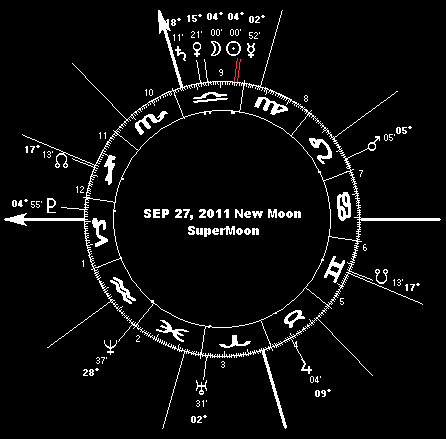 October features a lot of the celestial action that defines much of 2012, in a number of ways. Theres the October 27 start of the 2011-2012 Mars Max cycle, the continuing tail-off from the 2010-2011 Venus Max, the temporary easing of the Uranus-Pluto quadrature (since Pluto returned to direct apparent motion last month). Those are just the ongoing themes. October also has some highlights in its own right, beginning with the lingering Venus-Saturn alignment from last month (a sight to see in the west at sunset). And theres lots of drama as the month wraps up under the aegis of the SuperMoon on the 26th, as Mars aligns in opposition to Neptune, Mercury and Venus move to within a hairs breadth of conjunction in the western sky at sunset, and a dazzlingly luminous Jupiter rises in the east all pretty much at once. All in all, theres lots of excitement in the air this month; some of it the kind that makes you smile, some of it the kind that makes you want to duck and weave. Here are the details . . .
October features a lot of the celestial action that defines much of 2012, in a number of ways. Theres the October 27 start of the 2011-2012 Mars Max cycle, the continuing tail-off from the 2010-2011 Venus Max, the temporary easing of the Uranus-Pluto quadrature (since Pluto returned to direct apparent motion last month). Those are just the ongoing themes. October also has some highlights in its own right, beginning with the lingering Venus-Saturn alignment from last month (a sight to see in the west at sunset). And theres lots of drama as the month wraps up under the aegis of the SuperMoon on the 26th, as Mars aligns in opposition to Neptune, Mercury and Venus move to within a hairs breadth of conjunction in the western sky at sunset, and a dazzlingly luminous Jupiter rises in the east all pretty much at once. All in all, theres lots of excitement in the air this month; some of it the kind that makes you smile, some of it the kind that makes you want to duck and weave. Here are the details . . .
The month opens up in the tail end of the late September SuperMoon shock window (September 24-October 3). Any SuperMoon, by definition and as the one who created and defined the term, I can speak with some authority is a new or full moon that happens with the moon at or near (at least 90% of its peak value) the closest approach (perigee) it makes in its orbit around Earth. The September 27 SuperMoon was the first in the series of three autumn 2011 new moons that followed the three winter-spring full moon SuperMoons earlier in the year.
Any SuperMoon is associated with a higher-than-normal risk for elevated storm and seismic activity, and this latest one has been typical in that respect. From the time this particular geocosmic shock window opened on the 24th, weve seen 20 magnitude 5+ earthquakes, along with a number of killer storms: dozens of people died in heavy downpours in India on the weekend of September 24-25; while more than a dozen were killed when Typhoon Nesat hit the Philippines on the 27th, sending "waves as tall as palm trees crashing over seawalls." (Extreme tidal surges are typical SuperMoon phenomena.) No major volcanic eruptions yet, but there has been unusual activity. The El Hierro volcano in the Canary Islands, for example, has been increasingly active, with thousands of tremors having been recorded since July 19 but under the aegis of the September SuperMoon, local authorities ordered a mass evacuation from the area surrounding the volcano on September 28, after more than 150 tremors on the day of the SuperMoon alignment.
As mentioned, the September 27 SuperMoon shock window extends into October, through the 3rd: something to remember these next few days, which would be a good time to have your emergency kit ready, whether traveling or safely ensconced at home. Most especially, as described in my 2011 World Forecast Highlights, "if youll be in one of the astro-locality risk zones associated with this alignment. These include a longitudinal meridian line running through the Bering Strait, across the southern Aleutians and down through the Pacific Ocean, emerging on the other side of the world to cross west central Africa, central Europe and Scandinavia. Also rather risky-looking is the horizon arc through western South and Central America, Cuba, the Bahamas and the eastern US and Canada, across Greenland and down through central Asia from Russia through Mongolia, China, the Indochina Peninsula, Malaysia and Indonesia. Batten down the hatches, have the go-bag, candles, bottled water and canned foods ready just in case."
Storm and seismic activity aside, its worth remembering as we go into these last few SuperMoon days, that this alignment has been caught up in a T-Square pattern, as pointed out in my September forecast (published in August): "Sun, Moon and Mercury all oppose Uranus, while Pluto squares the whole face-off. Venus and Saturn are conjunct at the time, near the western horizon at sunset. Its a time for austerity, for taking profits, for backing away from the speculative in favor of the solid stuff. At least the crazies are mostly sitting on their hands, for lack of funds and other resources. This should make for something like a sullen peace, a certain gravitas."
That gravitas has manifested in the European Union (EU) making yet one more attempt to rescue itself from its ongoing sovereign debt crisis this last week or so. I cashed in my euro/dollar shorts during this period, figuring the market would be fooled by the latest Eurozone shenanigans. Sure enough, the euro/dollar bottomed out and began to climb during the September SuperMoon window. As I wrote in my Facebook post, I figure this EUphoria will carry the euro/dollar up to somewhere between $1.38 and $1.40 before reality sets in at which point it will be time to short the common currency again, I think. The time window for this may extend as far as the Venus-Pluto conjunction of December 1 but always be aware of my reminder not to make a fetish of exact dates, because theres plenty enough quantum flux in the flow of events to allow for at least a little latitude.
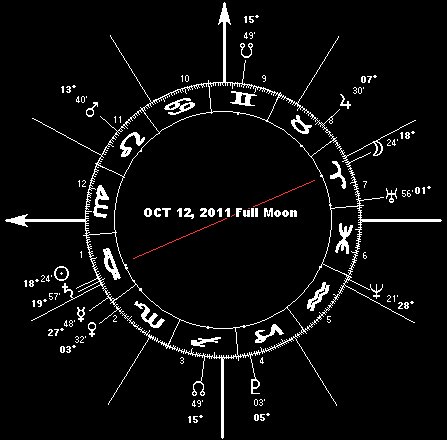 Speaking of markets and such, please be advised that although I do address market and economic developments in my forecasts, I cannot nor will I be responsible for anyone's trades or investments but my own. I'm not a CFP (Certified Financial Planner), RIA (Registered Investment Adviser), or anything of the sort. I'm not even a financial astrologer per se, although many people seem to think I am. Technically speaking, financial astrology is a subset of what's called mundane astrology. I've been a full-time professional astrologer and astrology writer since 1973, and I've been writing on the subject of mundane astrology for over 30 years now - including the world forecasts for Dell Publishing Company's HOROSCOPE Yearbook for many years, and the annual as well as monthly forecasts at my website.
Speaking of markets and such, please be advised that although I do address market and economic developments in my forecasts, I cannot nor will I be responsible for anyone's trades or investments but my own. I'm not a CFP (Certified Financial Planner), RIA (Registered Investment Adviser), or anything of the sort. I'm not even a financial astrologer per se, although many people seem to think I am. Technically speaking, financial astrology is a subset of what's called mundane astrology. I've been a full-time professional astrologer and astrology writer since 1973, and I've been writing on the subject of mundane astrology for over 30 years now - including the world forecasts for Dell Publishing Company's HOROSCOPE Yearbook for many years, and the annual as well as monthly forecasts at my website.
In lay terms, I'm just an astrologer with a particular interest in planetary cycles, history and the markets. I'm happy to share what I can see of economic cycles, market trends and the like through my forecasts, and I do act on these things myself. But I do not advise anyone else to do so. Anyone who's considering doing as I do, does so at his or her own risk, and should consult a trusted and qualified financial advisor before acting on anything I write. Just try not to get one of the bozos who let everybody's 401(k) tank back in the day . . .
That said, there are plenty of reasons to believe that markets and economies around the world will be months before resuming some kind of steady progress. For one thing, theres the fact that the next Venus Max doesnt begin until late March, 2012. Im not saying that theres a steady, ongoing crash for all those months. It looks to me more like a range with a bit of a downward bias. Most especially for the first half of October, what with the Uranus-Pluto quadrature that remains within a few degrees of exact during this period. A bit of a rally is due within a few days either side of the Venus-Jupiter opposition on the 14th. Temporary, but welcome. The Uranus-Pluto square, after all, starts forming again when Uranus goes direct in December . . . and moves to within a few degrees of exact once more in April 2012, heading for the first of seven 2012-2015 square alignments on June 24. And in any event, as Ive been writing for years now, it looks as though what passes for a full recovery wont be here until the 2020 Jupiter-Saturn Trigonalis which signals the arrival of what amounts to a new civilization, much as the Industrial Revolution supplanted the agricultural civilization in the wake of the last Trigonalis.
Keep an eye on the sky during this months full moon geophysical shock window. While its neither a SuperMoon nor an eclipse, this one still bears watching when it comes to storm and seismic headlines, from local storms to tropical cyclones, from moderate-to-severe earthquakes (magnitude 5 and up) to volcanic eruptions. This particular window runs a little on the wide side, from late on the 8th (as the Moons northward equatorial crossing takes hold through early on the 18th (in the wake of the lunar north declination peak on the 17th). In particular, the 9th, 12th (the day of the full moon), 13th (the Moon-Jupiter conjunction opposite) and the 17th look like focal points for storm and seismic activity within this over-all period of vulnerability. Take precautions, make preparations, and then rest easy knowing youre as ready as can be.
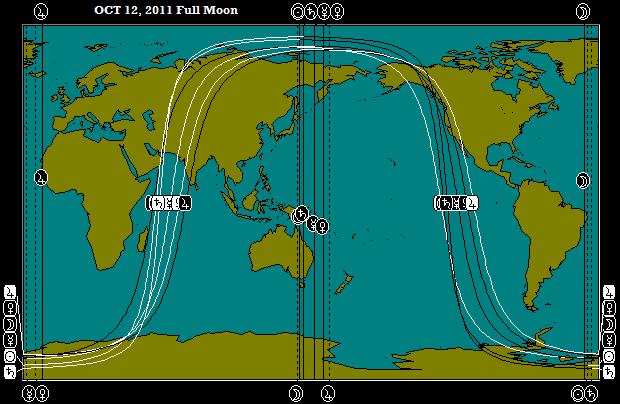 As always, alignments like this are astronomical in scale and therefore planet-wide in risk potential. No place on Earth is beyond the reach of severe weather, even if seismic events tend to cluster in recognized zones like the Pacific "Ring of Fire". That said, key astro-locality lines may point out areas of particular risk in this particular full moon period. If youre unfamiliar with astro-locality mapping, the heart of the matter is that these maps show where on Earth the planets (and other points) are rising/setting and culminating/anti-culminating at the moment of an event a birth, a planetary configuration, etc. Rising and setting should be self-explanatory. Culminating/anti-culminating roughly equates to being directly overhead/directly below. The rising/setting lines are curving arcs, while the culminate/anti-culminate lines are longitudinal (straight up and down, i.e. north-south). In the format I use (Esoteric Technologies Solar Fire), rising arcs are white, setting arcs are black; culminating lines are solid, anti-culminating lines are dashed.
As always, alignments like this are astronomical in scale and therefore planet-wide in risk potential. No place on Earth is beyond the reach of severe weather, even if seismic events tend to cluster in recognized zones like the Pacific "Ring of Fire". That said, key astro-locality lines may point out areas of particular risk in this particular full moon period. If youre unfamiliar with astro-locality mapping, the heart of the matter is that these maps show where on Earth the planets (and other points) are rising/setting and culminating/anti-culminating at the moment of an event a birth, a planetary configuration, etc. Rising and setting should be self-explanatory. Culminating/anti-culminating roughly equates to being directly overhead/directly below. The rising/setting lines are curving arcs, while the culminate/anti-culminate lines are longitudinal (straight up and down, i.e. north-south). In the format I use (Esoteric Technologies Solar Fire), rising arcs are white, setting arcs are black; culminating lines are solid, anti-culminating lines are dashed.
Looking at the astro-locality map for the emphasized points in the October 12 full moon, for example, theres a wide band of curving horizon arcs through Southwest Asia (including Iran, Pakistan and India), across western China and Russia in the eastern hemisphere, and down through Alaska and the Pacific coast of North America in the west. Longitudinal meridian/anti-meridian arcs run from Greenland and Iceland through the Atlantic coast of Africa; as well as from Siberia down through Japan, Papua New Guinea and eastern Australia. Theres also another longitudinal arc from eastern Greenland down through the Atlantic to the east coast of Brazil.
Again, let me emphasize: these are areas of potential emphasized risk for notable storm and seismic activity during the October 8-18 full moon shock window. Most assuredly, these will NOT be the only places well see such events.
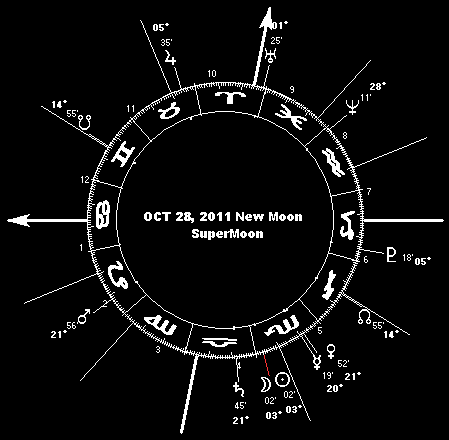 The October 26 new moon SuperMoon at 3° 03 Scorpio anchors a geocosmic shock window that runs from the 23rd through the 30th. Opposing Jupiter putting the Giant Planet in its annual closest approach to Earth and happening with Mercury and Venus just a couple degrees apart in the evening sky, this looks like a respectable storm and seismic signal. And something of a financial up-tick as well: it should be good for bonds, stocks and good strong currencies. Increased production and hiring look like part of this SuperMoon. This isnt the Second Coming, by any means: the return of prosperity is years away yet, and this will prove a welcome yet only temporary respite along that path. Moreover, economic disruptions due to storm-related (or seismic) infrastructure damage can take the bloom off the rose at least for a time.
The October 26 new moon SuperMoon at 3° 03 Scorpio anchors a geocosmic shock window that runs from the 23rd through the 30th. Opposing Jupiter putting the Giant Planet in its annual closest approach to Earth and happening with Mercury and Venus just a couple degrees apart in the evening sky, this looks like a respectable storm and seismic signal. And something of a financial up-tick as well: it should be good for bonds, stocks and good strong currencies. Increased production and hiring look like part of this SuperMoon. This isnt the Second Coming, by any means: the return of prosperity is years away yet, and this will prove a welcome yet only temporary respite along that path. Moreover, economic disruptions due to storm-related (or seismic) infrastructure damage can take the bloom off the rose at least for a time.
The likelihood of destructive storms, seismic events (including magnitude 5+ earthquakes and volcanic eruptions) as well as extreme tidal surges associated with the October 23-30 SuperMoon shock window is planet-wide in potential. If there are signs of particular target zones, they may be suggested by the astro-locality map for this alignment. This includes a longitudinal zone running from Iran up through Turkmenistan, Uzbekistan, Kazakhstan and Russia; and along the middle Pacific coast of North America (including Alaska, British Columbia, and the Pacific Northwest as well as California in the US). Theres also a horizon arc sweeping northeasterly through Australia and across Papua New Guinea, on through the Pacific to Kamchatka, crossing the Bering Strait and running along northern Canada before turning southward to pass through the Atlantic just off the eastern tip of Brazil. When the headlines of the day are written, theyre bound to include some extreme storm, tide and seismic activity along one or more of these zones. (Note that some of the same target zones are emphasized in both the full and new moon astro-locality maps.)
The near-conjunction of Mercury and Venus from late October (including the SuperMoon) into early November is worth noting in its own right. Theyll be not only a beautiful sight in the evening sky, but also a signal of increased solar activity (strong solar flares and Coronal Mass Ejections), and geomagnetic activity (including auroral displays); which in turn can be a harbinger of increased storm and seismic activity.
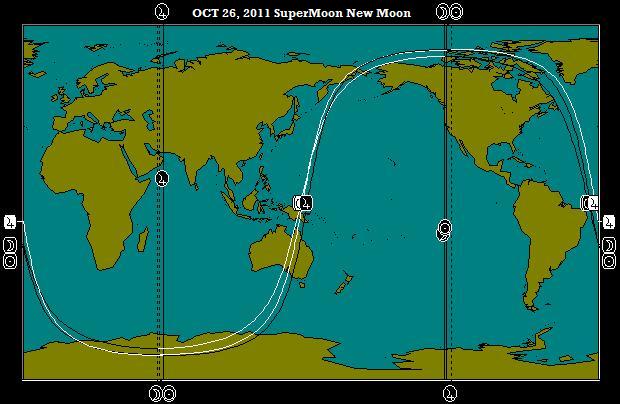 Last but very far from least is the upsurge in Mars activation this month. Im referring to the "Mars Max" cycle that starts this month, and lasts into summer 2012. It begins on October 28, when the Red Planet's daily apparent motion through Earth's sky drops below its mean motion for the first time since May 25, 2010 (the end of the last Mars Max cycle). This relative slow-down is the precursor to the Red Planet retrograde that begins on January 24, 2012 and ends a few months later on April 14. Mars Max also marks the beginning of the biennial Mars perigee phase, as Mars and our home planet come together for their close approach during the Sun-Mars opposition of March 3, 2012.
Last but very far from least is the upsurge in Mars activation this month. Im referring to the "Mars Max" cycle that starts this month, and lasts into summer 2012. It begins on October 28, when the Red Planet's daily apparent motion through Earth's sky drops below its mean motion for the first time since May 25, 2010 (the end of the last Mars Max cycle). This relative slow-down is the precursor to the Red Planet retrograde that begins on January 24, 2012 and ends a few months later on April 14. Mars Max also marks the beginning of the biennial Mars perigee phase, as Mars and our home planet come together for their close approach during the Sun-Mars opposition of March 3, 2012.
This proximity means that Mars gets brighter and bigger in the night sky, culminating in the March perigee and then slowly dimming back to normal. Likewise, all things pertaining to Mars loom larger and larger in human experience during this period: haste, heat, fire, danger, belligerence and conflict - literally and figuratively - are more and more on the rise during the October 2011-July 2012 Mars Max cycle. This means a spike across the whole spectrum of violence, from the individual to the collective, from domestic, school and workplace violence to mass murder and spree killings all the way to suicide bombings and other terrorist atrocities. Criminality, terrorism and military conflict are never rare, but they'll loom larger and larger in the news from late October 2011 into July of 2012. You know what copy writers say: "If it bleeds, it leads." They'll have plenty of material to work with as Mars looms large in the night sky.
At the height of the Mars Max, as Earth and the Red Planet are in their close approach, occurs the Mars retrograde. Astrologers who only know from ephemerides miss the real meaning of retrogrades: they occur when a planet is nearest the Earth. When we step away from the ephemeris and out into the night sky, we see that the retrograde planet is as big and bright as it ever gets. Far from being weakened as those who dont know better believe that planet is in reality at its peak presence for those of us on Earth. The retrograde cycle, when the planet in question appears to reverse the direction of its apparent motion in our sky, is precisely when that planet is foremost not debilitated at all, but exalted if anything. And thats why Mars Max (and the retrograde it subsumes) is such an über Mars time.
Determining the beginning and end of one of these Mars Maximum cycles is a bit tricky. With the inferior planets, Mercury and Venus, it's pretty easy to tell when the close approach phase is active. It stretches from the maximum eastern elongation (evening star apparition) through the retrograde to the maximum western elongation (morning star). With superior planets - those from Mars outward - there's no similarly obvious astronomical cue. Over the years, I have experimented with using the geocentric Sun-Mars squares (90° and 270° arcs) as delimiters for the Mars Maximum cycle. I've also tried the heliocentric Earth-Mars squares. Nothing really quite fit. After some years observing and researching it, I am persuaded that a superior planet's close approach cycle effectively begins when its daily apparent motion drops below its mean value, extends through the retrograde, and continues until daily apparent motion surpasses the mean daily motion again. (See the animation to get a view of the cycle as a whole.)
 I hasten to add that it's not enough just to use the mean daily motion for a superior planet's synodic cycle. That's too rough a measure, because it fails to take into account the relationship between Earth and the planet in question. Take Mars, for example. It makes one orbit in about the time Earth makes two. Mars' mean daily apparent motion for the entire cycle is 0° 31'. However, for roughly half of the Mars cycle, it is physically closer to Earth and therefore moving relatively slowly through our sky. During the other half of the Mars cycle, the Red Planet is on the far side of the Sun from Earth and therefore has a faster apparent motion. There are other factors affecting the daily apparent motion of Mars, such as its perihelion (close approach to the Sun, the faster end of its orbit) and aphelion (the opposite point); as well as Earth's perihelion and aphelion.
I hasten to add that it's not enough just to use the mean daily motion for a superior planet's synodic cycle. That's too rough a measure, because it fails to take into account the relationship between Earth and the planet in question. Take Mars, for example. It makes one orbit in about the time Earth makes two. Mars' mean daily apparent motion for the entire cycle is 0° 31'. However, for roughly half of the Mars cycle, it is physically closer to Earth and therefore moving relatively slowly through our sky. During the other half of the Mars cycle, the Red Planet is on the far side of the Sun from Earth and therefore has a faster apparent motion. There are other factors affecting the daily apparent motion of Mars, such as its perihelion (close approach to the Sun, the faster end of its orbit) and aphelion (the opposite point); as well as Earth's perihelion and aphelion.
To adjust for these variables, I calculate the mean daily apparent motion of the superior planet from its conjunction with the Sun to its solar opposition, and from opposition back to conjunction. Each of these halves of the cycle has its own mean daily motion. In the case of Mars, for example, its 2011-2012 close approach cycle begins on October 28, 2011, when the Red Planet's daily motion drops below its mean value (0° 32.7') for the period from the February 4, 2011 Sun-Mars conjunction to the March 3, 2012 Sun-Mars opposition. The cycle continues until July 12, 2012, when the daily apparent motion of Mars finally gets back up to the mean daily motion (0° 32.9') for the period from the March 3, 2012 Sun-Mars opposition to the April 18, 2013 Sun-Mars conjunction. What to expect? Let's look at the record . . .
The most recent (2009-2010) Mars Max began the same day (September 23, 2009) that the US, Great Britain and France exposed and denounced Iran's secret nuclear facility - to which Iran responded within days by launching a barrage of ballistic missiles in what was termed an exercise unrelated to the nuclear program controversy. From that time forward, there was a surplus of "if it bleeds, it leads" headlines all the way through that particular Mars Max, which ended May 25, 2010. These included the Fort Hood massacre, the Christmas Day suicide bomber attack on a Northwest airliner, the February 12 start of the major offensive in Afghanistan (one of the target zones right under Mars, as mentioned in my 2010 forecast); as well as the mass murder at the University of Alabama Huntsville (UAH) and the kamikaze attack on the IRS office in Austin TX. (In both these latter two instances, the perpetrator was actually born under a Mars Max.) And then there was the attack on the South Korean corvette Cheonan, torpedoed and sunk with a loss of 46 crew by a North Korean submarine on March 26; and the female suicide bomber attacks on the Moscow subway system on March 29. Ironically, the very first female suicide bomber attack on the Moscow subway took place in July 2003 - during a previous Mars Max cycle. And likewise the Korean War began under a Mars Max as well. (You just can't make this stuff up.)
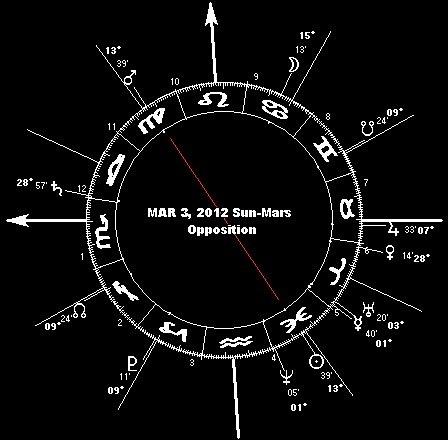 By far the most significant of the 2009-2010 Mars Max events - environmentally and economically, at least - was the catastrophic explosion of BP's Deepwater Horizon rig and the blowout of the Macondo well in the Gulf of Mexico. It happened on April 20, in the midst of the Mars Max cycle described in my 2010 forecast as a harbinger of "fires, clashes, crashes and explosions . . . a disruption in the oil and natural gas supply chain." (And right in one of the particular Mars Max risk periods for April, as described in my online forecast for that month: "around the 22nd when the Moon aligns with Mars.")
By far the most significant of the 2009-2010 Mars Max events - environmentally and economically, at least - was the catastrophic explosion of BP's Deepwater Horizon rig and the blowout of the Macondo well in the Gulf of Mexico. It happened on April 20, in the midst of the Mars Max cycle described in my 2010 forecast as a harbinger of "fires, clashes, crashes and explosions . . . a disruption in the oil and natural gas supply chain." (And right in one of the particular Mars Max risk periods for April, as described in my online forecast for that month: "around the 22nd when the Moon aligns with Mars.")
The previous Mars Max heralded the September 6, 2007 Israel air attack on Syria's nuclear facility, which came just three days after Mars' daily motion dropped to below its mean value for the period between the October 23, 2006 Sun-Mars conjunction and the December 24, 2007 Sun-Mars opposition - three days before Pakistani Presidential candidate Benazir Bhutto was assassinated. (The mean daily motion for this period was 0d 34' of arc.)
Before that came the Mars Super Maximum of 2003 (as the insurgency phase got underway in Gulf War II). The latter Mars alignment was historic, being the closest pass between Earth and Mars since Neanderthal Man shared the planet with our own species. It was chief among the factors that led to my 2003 World Forecast Highlights prediction that the Persian Gulf War II would break out that year, and then get really messy that summer: "Whoever thinks a swiftly concluded Persian Gulf War II settles the world into a Pax Americana early in 2003 is tragically mistaken. This late summer super Mars thing says peace and quiet remains far away, that danger and conflict are close at hand."
The September 11, 2001 terrorist air attacks on the US came less than a week before Mars' daily motion finally came back up to its mean value (0° 33') for the period between the June 13, 2001 Sun-Mars opposition and the August 10, 2002 Sun-Mars conjunction. Clearly, these Mars Maximum cycles promise saber-rattling - and threaten worse.
Mars phases of this sort happen once every couple years or so. Obviously, we've survived plenty of them to date. This isn't Armageddon, in other words. It's just a predictable upsurge in the already considerable nominal human penchant for mayhem: plenty sufficient to make for a surfeit of those "if it bleeds, it leads" headlines, but not likely the harbinger of the next world war - let alone some kind of mass extinction event. Such Red Planet close approaches are not unlike the Max cycles of Mercury and Venus, in that they emphasize the nature of the planet in question during that portion of its orbit where it passes closest to Earth. So the high Mars cycle that begins this month and concludes in July 2012 indicates a period of elevated tension and conflict, the kind of atmosphere that cultivates inflamed passions, hot tempers and rash, even violent action - of the criminal and military type, from terrorist atrocities to large scale military conflict. (Not to mention the smaller scale stuff like domestic violence, school and workplace shootings, mass murders and spree killings, etc.) A notable increase in dangerous fires, crashes and explosions is also typical of the Mars Max cycle, which is accompanied by rash, hasty and impulsive action generally.
Apart from the direct impact of the fires, clashes, crashes and explosions that are par for the course under this sort of Mars close pass, some such incidents can raise the possibility of a disruption in the oil and natural gas supply chain - which in turn can shock the financial markets and set investors and institutions in a mad dash for the exits. Military conflicts can have the same effect - and not only on energy supplies specifically, but on the whole spectrum of commerce. The centerpiece of this particular Mars Max, the March 2012 Sun-Mars opposition, also features a Venus-Saturn alignment; which suggests a strong potential for greater or lesser financial panics stemming from mishaps and misadventures associated with this Mars cycle - and certainly not only around the time of the Sun-Mars and Venus-Saturn alignments themselves, but throughout the Mars Max phase.
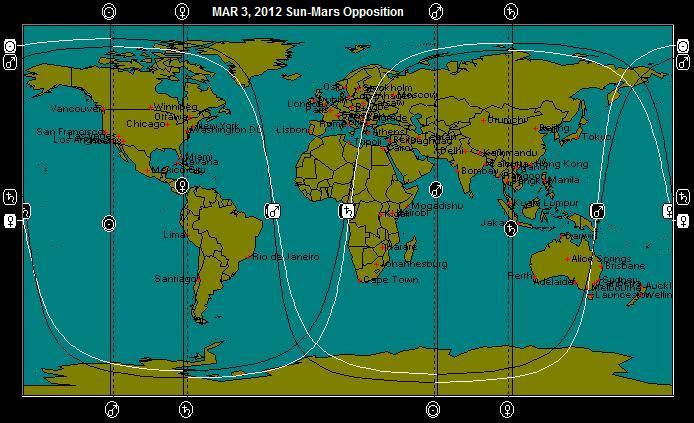 Being months in duration and planetary in scale, you can pretty well figure that Mars Max effects will be seen worldwide. But there may be one very broad hint as to areas of particular vulnerability during this cycle. Astro-locality mapping the March 3, 2012 Sun-Mars opposition that anchors the 2011-2012 Mars Max cycle reveals several longitudinal special risk zones, including one in the western US from southern California in the vicinity of Los Angeles due north through western Canada, passing over the pole to come down through Russia and the Middle East in the area of the border Iran shares with Afghanistan and Pakistan. Except for skimming the far north of Canada and the southern tip of Greenland, the Sun-Mars horizon arc mostly spans open ocean - except where it touches eastern Australia (around Melbourne), Papua New Guinea and New Britain on its way across the Pacific to the Kamchatka Peninsula and the coast of Siberia.
Being months in duration and planetary in scale, you can pretty well figure that Mars Max effects will be seen worldwide. But there may be one very broad hint as to areas of particular vulnerability during this cycle. Astro-locality mapping the March 3, 2012 Sun-Mars opposition that anchors the 2011-2012 Mars Max cycle reveals several longitudinal special risk zones, including one in the western US from southern California in the vicinity of Los Angeles due north through western Canada, passing over the pole to come down through Russia and the Middle East in the area of the border Iran shares with Afghanistan and Pakistan. Except for skimming the far north of Canada and the southern tip of Greenland, the Sun-Mars horizon arc mostly spans open ocean - except where it touches eastern Australia (around Melbourne), Papua New Guinea and New Britain on its way across the Pacific to the Kamchatka Peninsula and the coast of Siberia.
Once the history of the 2011-2012 Mars Max cycle is written, the above-mentioned danger zones will figure prominently - though certainly not exclusively - when it comes to the "if it bleeds, it leads" headlines of the times: the fires, crashes, explosions, military/paramilitary attacks (including terrorism) and criminal violence, etc. Astro-locality mapping the Sun-Mars opposition anchor of the 2009-2010 Mars Max showed Afghanistan right under the Mars meridian line for this alignment, for example. That was indeed the locus for the biggest military conflict of the year, but there was a whole lot more to the Red Planet story during that period. As I wrote in my 2010 forecast, "these are some but not all of the focal zones for the alignment." And so it will be for the Mars Max that gets underway this month.
We'll have plenty of time to watch the headlines and observe the Mars Maximum correlates as they develop. Just remember that they don't develop only `out there' in the world at large. They're also alive in us, in the people around us. This is a time to be safety conscious, to get a grip on the animal spirits within and channel them productively rather than letting them loose on anyone who gets your goat. If people are cranky, if you're short tempered too, realize that this is just the nature of the time/space field for now, and do your best to ride it out with as little drama and damage as possible.
In the span of the 2011-2012 Mars Max cycle as a whole, there are more than a few temporal hot spots during this close approach of the Red Planet; mostly in 2012 because the cycle begins so late in 2011. Youll see them this month, commencing with the October 26-28 squares to Mars from Venus and Mercury and the October 28, 2011 Mars Max starting point itself. Remember, Mars aspects are effective for a number of days before and after theyre exact sometimes a week or more, when relative apparent motion of the planets involved is slow.
 SPECIAL FEATURE: This month's birthdays of the famous and infamous (with astrological birth charts)
SPECIAL FEATURE: This month's birthdays of the famous and infamous (with astrological birth charts)